What is Cohousing?
Understanding Cohousing
Cohousing is a sustainable and affordable approach to living in community. Cohousing communities are intentional communities, with people seeking out a community feel to their home lives. They are created and run by their residents cooperating to create better lives. Each household has a self-contained, private home as well as shared community space. Residents come together to manage their community, share activities, and regularly eat together.

As lives become more stressful, Cohousing is a way of resolving the isolation many people experience today and providing for a sense of community. Cohousing communities can be intergenerational, welcoming anyone of any age and any family structure, or specifically cater for people who are older or are communities of common interest or needs. The size and scale of cohousing is appropriate to support community dynamics for easy informal communal contact: usually between 8-50 households.
Sections:
What is Cohousing?
Common Element of Cohousing
Benefits of Cohousing
Why should Cohousing gets Policy Support?
Role of State and Local government
What is cohousing?
Cohousing is a co-governing intentional community development purposely established and maintained by residents who live in co-located private dwellings with substantial shared spaces and facilities. Cohousing is both a particular type of multi-dwelling built development and a legally constituted residential community organisation for co-governing their commonly shared land and built spaces, facilities, services and amenities. Cohousing can include one or more forms of tenancies: home-owners, private tenants and social housing tenants.
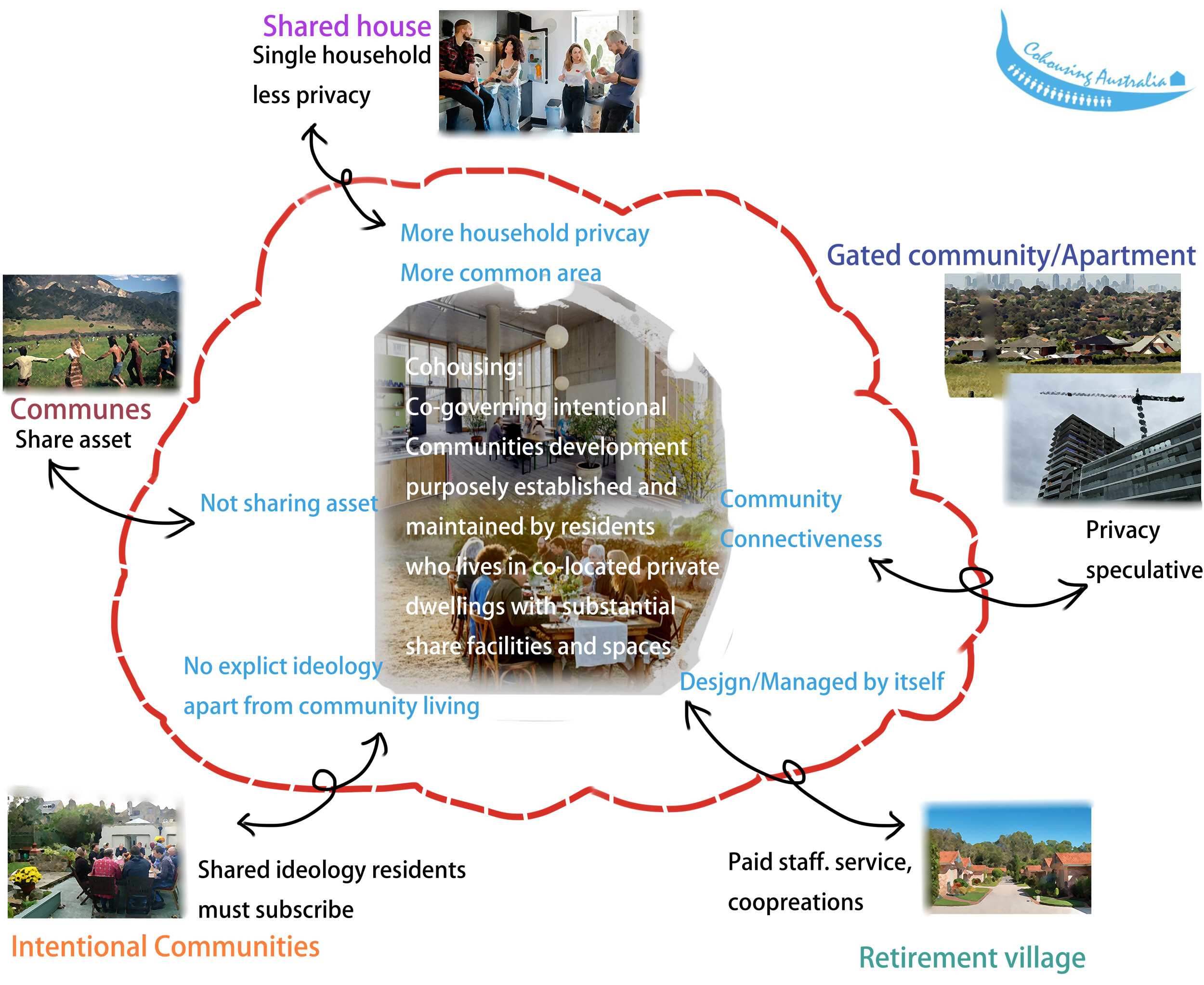
Cohousing Australia is keen to ensure that only intentional and co-governed resident-driven housing communities are recognised as ‘cohousing’ and, thus, eligible to gain relevant regulatory exemptions and policy incentives. Thus, at a minimum, a cohousing community needs to demonstrate that it has a formal legal constitution; collaboratively designs its cohousing development to facilitate community use, management and interaction; has an established or planned cohousing development featuring both private dwellings and substantial specifically-designated co-managed shared spaces and facilities — at a minimum a common house including shared and co-governed kitchen and dining facilities, shared garden areas and shared bicycle and/or car parking.
A cohousing development and cohousing community is distinguished from other forms of multi-dwelling developments with shared amenities — such as non-speculative multi-dwelling ‘deliberative developments’, boarding houses and residential parks — by its intentional and formal constitution as a co-governing multi-household community housing typology. The definitions of a cohousing development and cohousing community clearly distinguish cohousing as a co-governing multi-dwelling community housing typology providing specified social, environmental and economic benefits to the broader neighbourhood and demanding special treatment vis-à-vis multi-dwelling regulations. Such benefits include providing spaces and services (such as community gardens, co-working spaces and event hire space) that non-cohousing community neighbours can access.
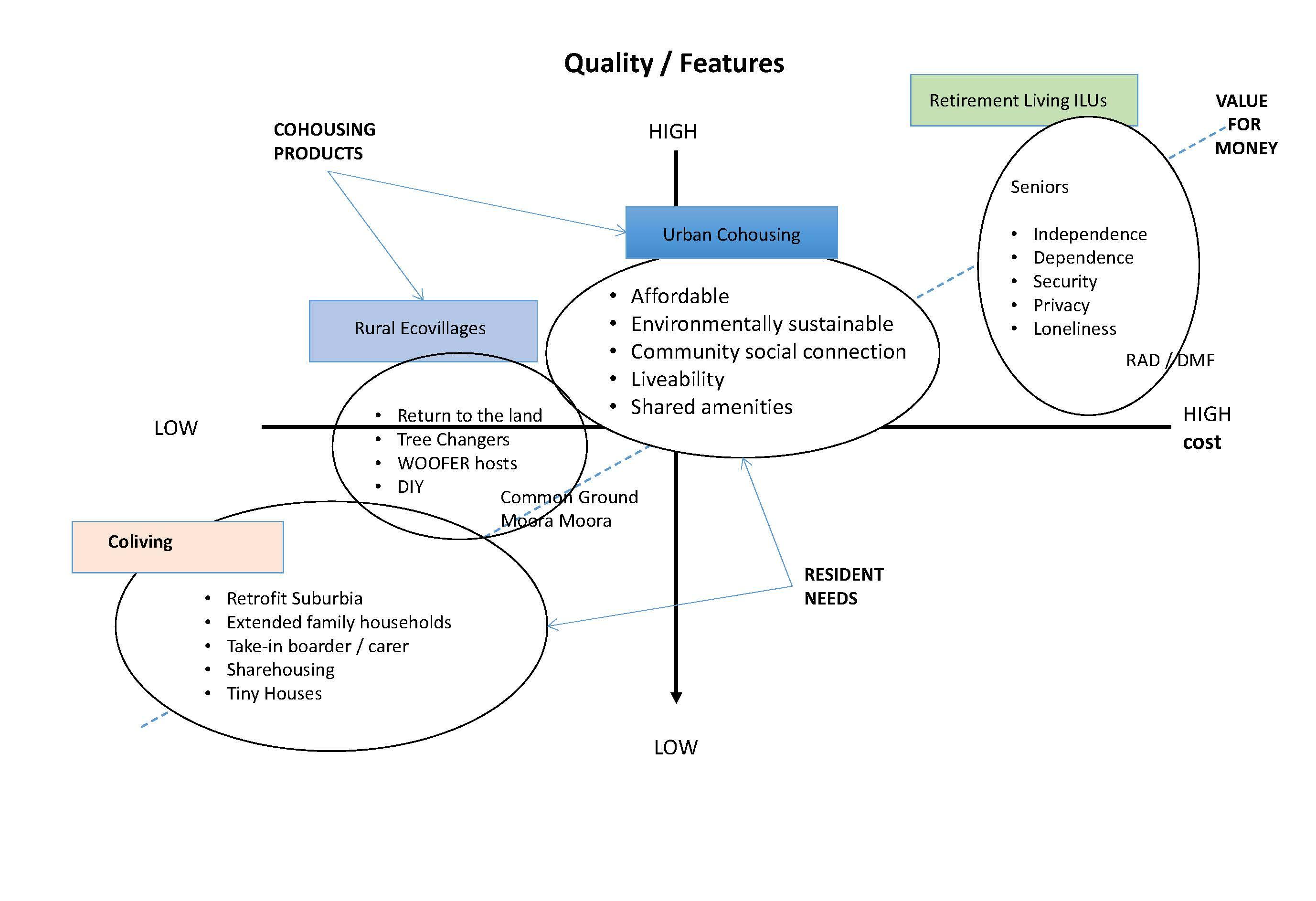
back to top
Common Elements of Cohousing communities
Cohousing is co-designed with communities concerned about sustainable living. Projects are community led providing for end users to contribute significantly to the design of the cohousing community by taking an active role in creating not only the built form but also the community. Design is used to encourage social interaction, for example by keeping cars to the periphery and putting common areas in the centre of the site.
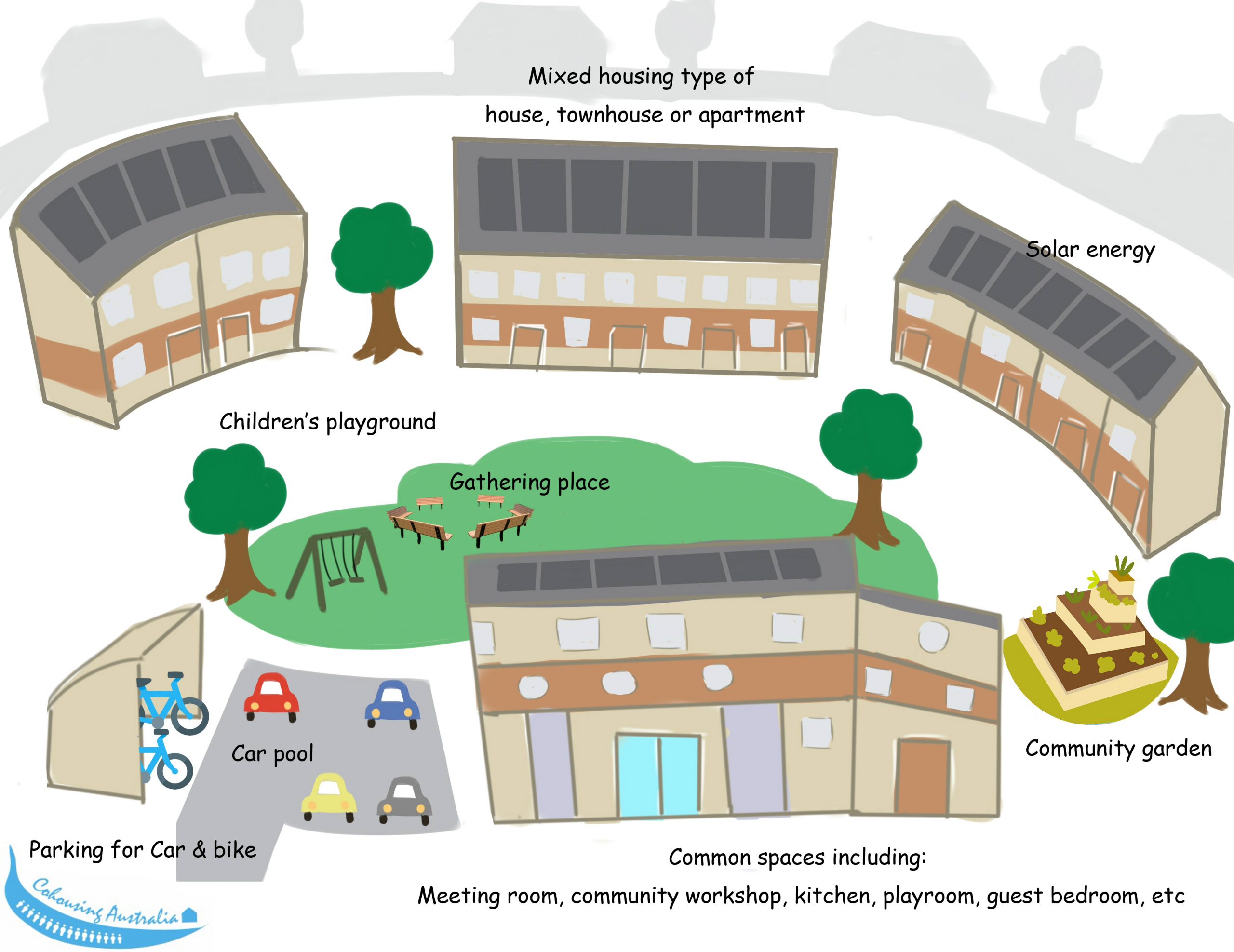
Cohousing includes both the provision of private and common facilities providing a balance between privacy and community. Most cohousing communities have shared indoor and outdoor facilities such as cooking and dining spaces, meeting and play areas, food growing, laundries and guest rooms. This means that the private dwellings are smaller as residents also have the benefit of the common facilities.
Cohousing embeds collective resident control and stewardship into its legal form and decision making. Residents manage their own community, looking after the maintenance, running the finances, tending the gardens, organising shared activities and developing tools and approaches to manage community dynamics. The community is governed in a non-hierarchical way, often using consensus decision making and /or concepts such as sociocracy. This encourages people to support each other and the promotion of a community spirit.
Cohousing communities are inclusive and part of the wider community
Cohousing communities actively encourage open membership. People wishing to join a group will need to work out if cohousing is right for them. Cohousing groups often host wider community activities in the shared space and common house, and support wider community projects.

back to top
Benefits of Cohousing
Affordable
The collective nature of Cohousing means when a group pools its resources, the members significantly increase their buying power. Resident-driven Cohousing has potential for greater affordability by internalising developer margins and eliminating marketing costs. Smaller, energy efficient homes cost less to build and run. Communities can organise opportunities to reduce daily living costs through shared laundries, community meals and bulk food purchasing. These all contribute to reduced cost of living and long term affordability.
Sustainable and good for the environment
Community laundries, car share and food cooperative, reduce costs. Sharing equipment such as tools, lawnmowers and play facilities between households saves money and makes better use of them. In line with reducing ongoing costs cohousing generally has a focus on passive design for energy and water efficiencies and waste reduction, and minimise car use promote walking, cycling and public transport.
Better quality of life, well-being and resilience
Loneliness, depression and social isolation are growing problems. In Cohousing, residents often meet up to eat together, chat, organise and socialise. Gardens and shared spaces are situated to encourage interaction between residents and the local community. The care and connections that are fostered in cohousing lead to a wide range of possibilities. For example, residents report avoiding prolonged hospital stays, having fun community events and spending less time on maintenance. Cohousing has the potential to keep older people active, healthy and engaged, and reduces the demand for health and social care services. Research tells us that developing strong social connections is fundamental to individual and community health and wellbeing.
Security and sense of safety
In a cohousing community people do not keep a check on each other’s whereabouts, but will instinctively know if something is out of the ordinary. Cohousing design encourages shared pedestrianised walkways and car-free central shared gardens providing for passive surveillance and safe spaces for outdoor activities.
Independent community management
The community decides together how things are organised; there is no external management committee. It starts from the beginning when future residents have an active say in the design of the community. This also creates a cooperation, a sense of place and ownership of issues and solutions and allows for adaptable, customised living solutions.
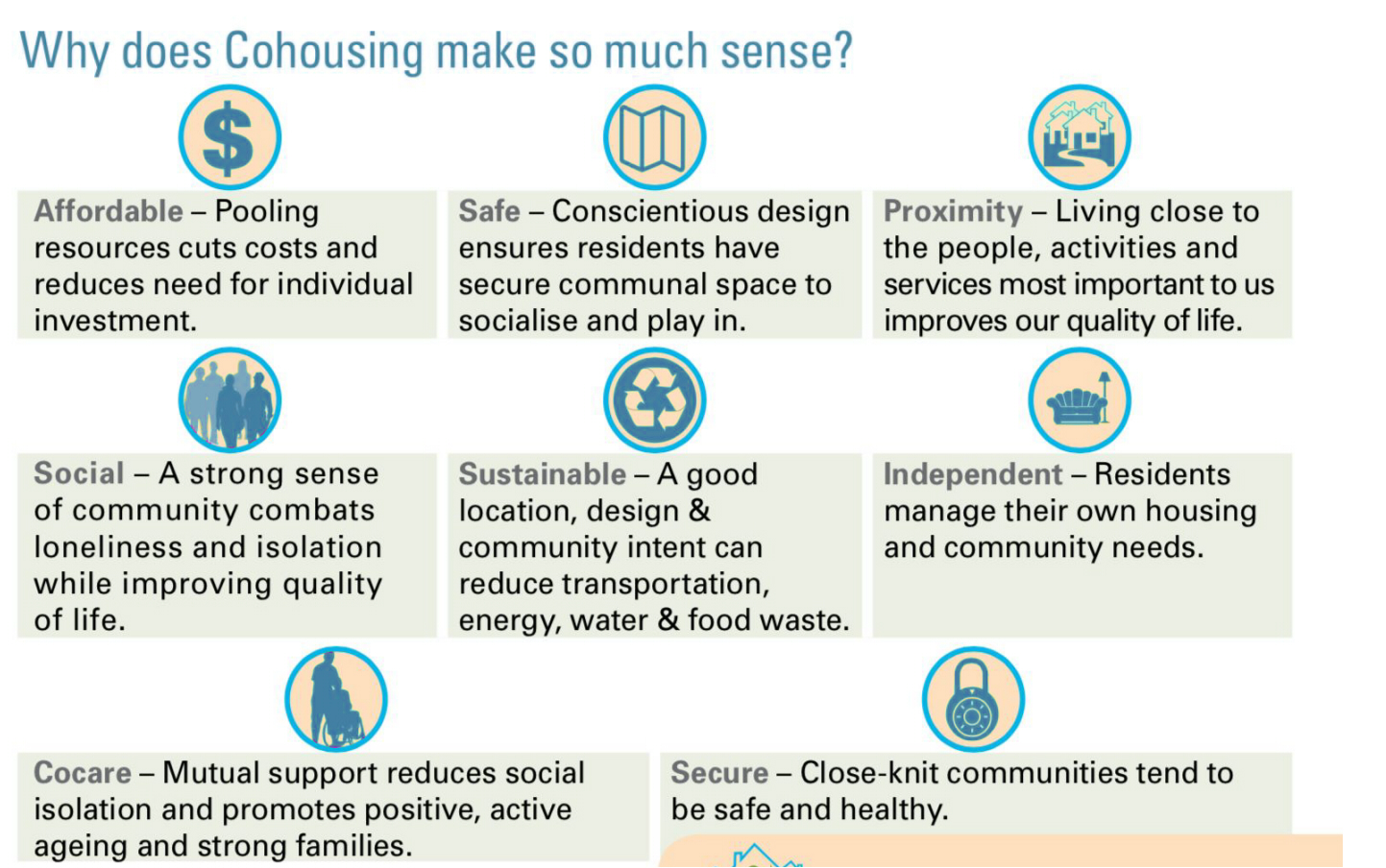
back to top
Why all levels of Government should support Cohousing
Has potential to assist in dealing with key issues that Australians are currently concerned about:
- Cost of living
- Health care, especially mental health
- Safety and security
- Lack of connection resulting in loneliness, social isolation and depression
- Environmental sustainability, especially impacts climate change and over consumption
- Community resilience: ability to bounce back from disasters, extreme events and stresses.
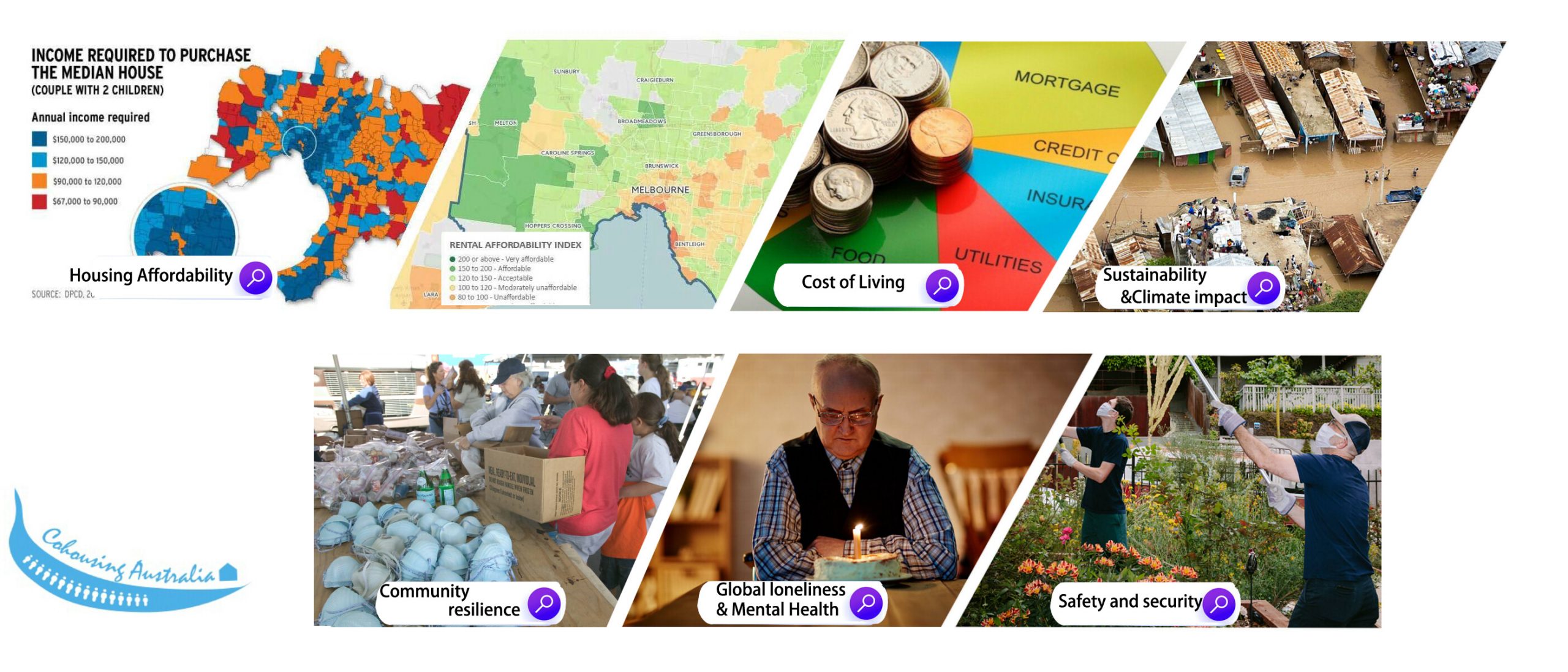
back to top
Role for State and Local Government
- Provide policy frameworkto support cohousing models
- Local Council instruments include: Council Plan; Municipal Strategic Statement (MSS), Housing Strategy, Structure Plans, Masterplans, rezoning requirements
- Provide supportiveplanning tools: wavering car parking; providing exemptions from developer contributions; assessments to deal with shared community facilities and spaces; legal agreements attached to permit applications capping profit margins; recognition as a separate residential /land use category; provide pre permit application advice and a fast track process through planning application; reduce third party appeal rights;
- Build understandingof the social (community and health), environmental and economic benefits of cohousing
- Buildcapacity in communities to leverage opportunities to help build liveable cities
- Facilitate partnershipsand collaboration to set up pilot projects: especially providing opportunities for Housing Associations and Disability providers.
- Promote alternative housing delivery modelsthat increase affordability and provide social and environmental benefits.
- Provide financial supportvia grant funding, access to subsidised land, and promotion of financial mechanisms to support the establishment of Cohousing
- Provide public landfor private projects that support the social, cultural and urban planning goals of the city with incentives such as deferring payments until groups have fully formed and have planning approval.
- Provide training and support for cooperative management models.
